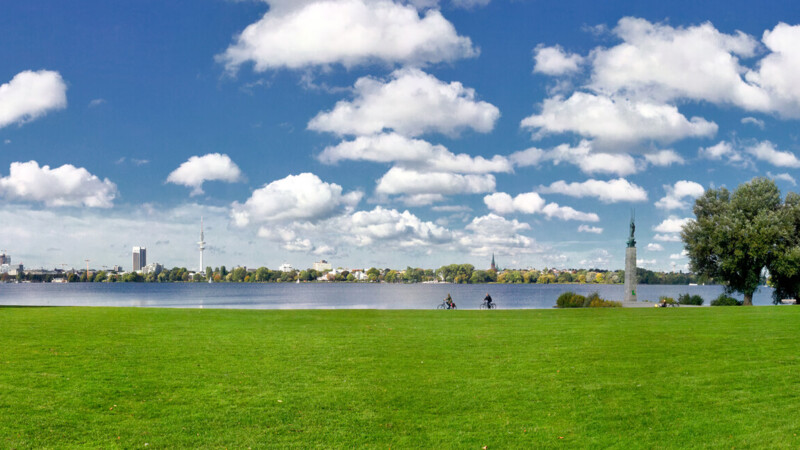The Fehmarnbelt crossing will halve the rail journey from Hamburg to Copenhagen from around five hours at present to two-and-a-half hours in future. The tunnel will bring northern Europe and Hamburg, Scandinavia's "southernmost metropolis", even closer together economically. Hamburg Invest established a strategic pillar of the German-Swedish economic relations when it helped set up a branch of the Swedish Chamber of Commerce in Hamburg in 2019. The chamber forges extensive economic links between the Kingdom of Sweden and the Federal Republic of Germany. Around 110 local companies are already members of the chamber including major players such as Vattenfall and Securitas.
Hamburg Airport operates many direct flights to cities throughout Scandinavia including Stockholm, Copenhagen, Oslo, Helsinki and Reykjavik. And now you can go to sleep in Hamburg and wake up in Stockholm aboard the daily overnight train "SJ Euronight" launched by Swedish railways in early 2023. The twelve-and-a-half-hour return journey also stops in Copenhagen and Malmö. The Hamburg Ambassadors, Leif Sjöström and Pekka Laaksonen in Stockholm and Helsinki respectively also foster Hanseatic-Scandinavian links which are likely to become even closer when the Fehrmarnbelt tunnel opens in 2029. The approximately 18-kilometre-long immersed tunnel will connect Lolland in Denmark and Fehmarn in Germany by rail and is enhanced by a four-lane motorway. The project is a key part of the Scandinavian-Mediterranean Corridor of the EU's core transport network and closes the gap between Scandinavian and European rail networks.
Hamburg - southernmost city in Scandinavia
Swedish settlements in Hamburg Metropolitan Region
The partnership with Scandinavia is central to Hamburg Invest's international activities. "The Scandinavian countries are among the top 10 in the Global Innovation Index year on year, and are seen as pioneers of innovative concepts in digitalisation and mobility. Nordic companies that settle in Hamburg consolidate the city's position as a dynamic and attractive centre of business and innovation," said Dr Rolf Strittmatter, Managing Director of Hamburg Invest. The decision by Sweden’s Northvolt to build a gigafactory for battery cells in Heide, in which Hamburg Invest played a key role, is an example of north Germany’s clout. The company plans to invest EUR 4.5 billion in the factory. Production is due to start in 2026, creating around 3,000 jobs. The factory in Heide and the headquarters in Hamburg have contributed significantly to the successful realisation of this flagship project with international appeal.

Trade relations since the Hanseatic League
Other companies such as the fintech Stock Republic and the IT company Consid have also moved to Hamburg. The latter is one the fastest growing companies in northern Europe and sets up digital business models based on its customers’ wishes. "We opted to expand to Hamburg because it is the economic centre of northern Europe. Due to its proximity to Scandinavia, interest in Swedish business culture and the experience of Swedish values in business relations is very high," said Patrick Hall, CEO of Consid. Germany and Sweden trade relations date back to the Hanseatic era. And trade remains buoyant. "Around 17 per cent of all goods imported to Sweden come from Germany and amounted to SEK 341 billion in 2023", (approx. 300 Milliarden Euro) according to the German-Swedish Chamber of Commerce. Conversely, Germany imported goods worth SEK 221 billion in 2023 (approx. 195 Milliarden Euro). More than 10 per cent of Swedish goods are exported to Germany every year and most are transhipped via the Port of Hamburg. Sweden is among its “top ten trading partners” in seaborne container traffic. Many of the containers belong to the global Danish Mærsk Line, whose German headquarters are in Hamburg. Founded in Copenhagen in 1928, the company operates more than 739 container ships and 67 terminals in 42 countries. In January, Mærsk and the Hamburg-based Hamburg Lloyd announced their "Gemini Cooperation" consisting of 290 ships with a combined capacity of 3.4 million standard containers of which Maersk is providing 60 per cent and Hapag-Lloyd 40 per cent.

Swedish ambassadors: Ikea and H&M
IKEA’s Billy shelves are likely among the goods transported by container. Around 35 years ago, IKEA opened its first store in Hamburg-Schnelsen followed by a furniture store in Moorfleet. The first downtown IKEA shop opened in June 2014 in Große Bergstraße in Altona which was Danish until 1864. Although the Altona train station is only 350 metres away, e-cargo bikes and e-cargo trailers can be hired to transport furniture and household items. The huge 18,000 square metre IKEA store also has a car park with charging points for electric cars. In 1980, Hennes & Mauritz (HM&), another global company of Swedish origin, opened its first German branch in the centre of Hamburg. Designed by the famous architect Volkwin Marg, the 200-metre arcade with glass roof was considered the “jewel among Hamburg’s arcades”, but was in danger of demolition before it was listed as a historical monument in 2018. H&M has since relocated its flagship store to the nearby Alsterhaus.

Love of Scandinavia in Hamburg
Another Swedish marker, the Scandic Hamburg Emporio, opened near Gänsemarkt. The hotel is one of the Scandic Hotels Group’s 280 in six countries. The first hotel called Esso Motorhotell opened in 1963 in Laxå in southern Sweden. Businessman Kurt Deitlaff’s love of antique Swedish tiled stoves prompted him to found the Svea Kachelöfen in 1992. Stoves from different eras are on sale in Martinistreet, in Lasbek in Schleswig-Holstein, at Lake Tegernsee and on Majorca. A total of 140,000 hours were spent toiling on the Scandinavian section of the world largest’s model railway Miniatur Wunderland in Hamburg’s Speicherstadt. Opened in 2005, the Scandinavian model is one of the largest and most technically complex with 40,000 figures on a 300 square metre area. The Baltic Sea in the centre has 30,000 litres of real water and a fleet of 16 ships. Thus, Hamburg and Scandinavia enjoy links on both a macro and level.
ys/pb
More
Similar articles

Hamburg to increase supply of hydrogen from Scandinavia

Hamburg Copenhagen Startup Forum to present latest green-tech ideas

Hamburg more international than ever
